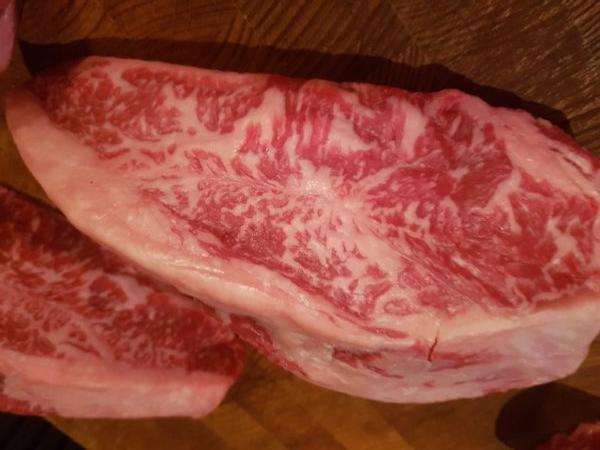Backed by MLA, the 2018 Team Te Mania workshop featured a diverse crowd of speakers – all with a focus on research and development of a profitable and sustainable beef industry. In the opening address, Michael Crowley, GM Producer Consultation and Adoption at MLA discussed latest research into profit drivers in the beef industry, value based marketing and new export opportunities for premium quality beef. Full report
In the Team Te Mania member Case Study, Dennis Gleeson shared an insight into the management of his property, Colligen Creek and neighboring Werai Station which he manages – a combined herd of 1900 Team Te Mania cattle, on-farm feedlot plus extensive cropping programs and a significant sheep flock.
The self-deprecating Dennis delivered an entertaining and enlightening account, with drone footage to boot. It was a story of building up enterprises, through a lot of hard work and good decision making. Dennis said he got involved in Team Te Mania because he could see the role of Angus in the market and within that, he could see Team Te Mania and TMA were delivering the results that would give him the maximum outcome.
Terry McCosker, Resource Consulting Services, Yeppoon, Queensland gave two presentations across the workshop.
One was on analysing a business, delivering a clear, step-by-step guide to understanding the best way to successfully manage a business beyond the traditional balance sheet and profit and loss statement.
He also said farmers must see themselves as being in charge of a number of enterprises and work out how they relate to each other and to cash flow.
That meant identifying the divisions you have, such as crop, sheep, cattle and/or contracting.
He said by doing a trading account on each enterprise, along with a gross margin, you could use all the true accurate costs and income from your multi-faceted enterprise to get an accurate running picture of your financial position.
His second presentation was on soils and carbon, a thought provoking and detailed assessment of the farming styles you could, and should, consider.
Terry said with every part of the farm was interlinked – the land, the people, the animals, the crops and the natural resources.
“You cannot reduce one without reducing all the others,” Terry explained.
“If we have reduced that pie through mismanagement it stands to reason you can increase that pie through better management,” he said.
Participants also heard about Terry’s holistic approach to not just farming but life itself – saying holism is the idea that natural systems should be viewed as wholes, not as collections of parts.
Terry also introduced us to carbon and the rhizosphere and their irreplaceable roles in successful farming.
“The essential components of a regenerative ecosystem are:
- Biodiversity
- Healthy soil
- Healthy plants
- Healthy animals
- Healthy food production
- Healthy people.”
Dr Robert Banks, Director of AGBU, said the Te Mania breeding program has made very impressive and valuable genetic progress over more than 2 decades. That genetic progress has been balanced – improvement in the right direction in
– Growth rate, but without any genetic increase in birth weight
– Carcase merit – muscling and marbling steadily improving, P8 and rib fat held constant
– Fertility – calving ease, gestation length and branding rate are all being improved
That genetic improvement means more calves, calves that grow faster to market weight, and calves that better meet market specifications.
What has underpinned this outstanding achievement?
The Te Mania breeding program has 2 great strengths:
– First, very comprehensive performance recording in the Te Mania stud, of large numbers of animals in large, carefully identified management groups. The traits recorded include the full range of weights (birth, weaning, yearling, and adult cow), live scan traits, on top of careful recording of complete pedigree and birth date. All calves born from 2016 onwards have been genotyped.
– Second, comprehensive recording in the Team Te Mania herds: herds using latest Te Mania genetics, and keeping full performance records. Steers from Team herds are also identified and recorded through the feedlot phase at Rangers Valley and get full carcase and meat quality data at slaughter.
Having these 2 components means that the breeding program is based on large amounts of relevant and carefully recorded data, and that data includes traits contributing to income and cost on- and off-farm. As an example, the genetic improvements in growth rate, muscling and marbling mean that more of the feeder cattle are meeting more and more valuable specifications each year – enabling Rangers Valley to plan ahead with more confidence and share the benefits with the commercial producers.
The genotyping of calves in the stud means that EBVs have improved accuracy, allowing more accurate selection of the best young animals, and also that all the data recorded through the value chain feeds into the EBVs for young animals. This means that young bulls and heifers are getting accurate EBVs for carcase marbling, based on the data collected on their relatives that have gone through to slaughter, and on similarities in the DNA patterns between the young animals and their relatives.
New R&D into the best indexes for the whole value chain shows that Te Mania genetic progress is running at just under $4 extra profit per cow joined per year – just under 4% profit growth per year. The R&D has fully incorporated feed costs at all points in the chain into the index, so the genetic improvement has accounted for any increase in amount of feed required.
There are some very important messages in these achievements, not just for the Te Mania network but also for the broader industry:
• The whole package depends on the relationship built up over years between the Stud, Team Te Mania and Rangers Valley. Working together, each player making their contribution, is yielding valuable results. Working together in this way achieves much more than the individual links (stud, commercial producer, feedlot) can achieve on their own
• The genetic improvement is delivering real profit growth – capturing that depends on, and rewards, excellent management on-farm and in the feedlot. Good management and good genetics are a win-win!
• And the cattle speak for themselves – reflecting the honesty and dedication to careful recording, balanced selection, and sharing information across the value chain.
Keith Howe, Managing Director, Rangers Valley talked about the close links between Team Te Mania and Rangers Valley being valuable for both parties. Compliance is a major profit driver for Rangers Valley, in their the Angus brand being long-fed (270 days), producing Black Onyx (marble score 3-4) and Black Market (marble score 5+). Participants at the Workshop had the experience of tasting sirloin cuts – marble score 7 and marble score 6, produced by Team Te Mania members, Jackson family, Toolong, Woolsthorpe, Vic and McFarlane family, Wellington Lodge, Taillem Bend, SA. The steers were sire identified and fed through Rangers Valley, and stunned the guests at dinner, for flavour and tenderness. Credit must also be paid to the Chef at the Torquay RACV resort, where the Workshop was held. Full story.
Bart Davidson from Maia Technology outlined the MaiaGrazing product, grazing management software that is part of the company’s suite in development, including a JV with eShepherd to create virtual fencing.
But said he thought it important to look at one critical aspect that falls out the bottom of MaiaGrazing, through the eyes of a property that has been with us since the start of our journey.
And that aspect is matching stocking rate to carrying capacity.
“However, MaiaGrazing is more than just matching stocking rate to carrying capacity – it is fundamentally a digitised grazing chart,” Bart said.
“This means it seamlessly records the stocking rate in the past, the present and the future… all relative to rainfall,” he said.
“This also means you have inventory covered and stock flow reports and production analytics per paddock you just won’t get any other way. That’s a fact, there are no better paddock analytics on the market.”
Climate Specialist, Dale Gray, from the Victorian Department of Agriculture, turned on a rapid fire account of weather patterns, along the way debunking (mostly) media reports about El Nino and SOI and others.
He also gave a colourful account of how the weather system actually works – it kept the participants entranced as he bounced about the stage with his sweeping predictions.
With the Pacific and Indian oceans still neutral, local weather patterns consisting of very high pressure systems over Australia, resulting in a continuation of the drier weather over Victoria’s north.
“Current predictions for the Pacific and Indian Oceans are all over the shop, but mainly sitting around neutral,” Dale said.
“Most models are still sitting on average rainfall for winter and spring, with average to warmer temperatures,” he said.
“Remembering that an average forecast in this context means an equal chance of above or below average rainfall.”
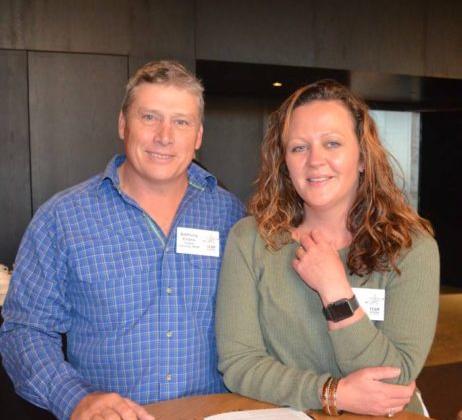 Anthony and Emma Evans, Gwalia, Adelong, NSW
Anthony and Emma Evans, Gwalia, Adelong, NSW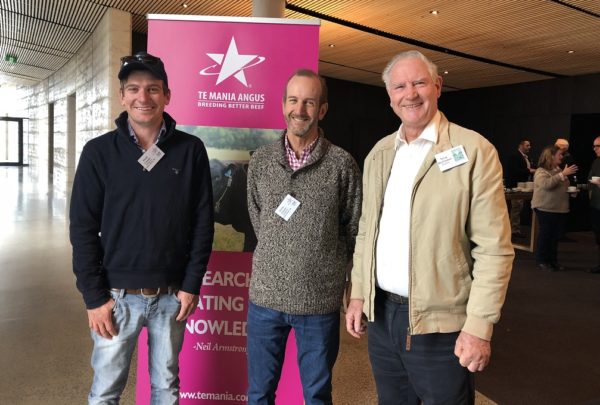 Team Te Mania members, Keith and Chris Cowan, Poltalloch, Tailem Bend, SA with Terry McCosker, Resource Consulting Services
Team Te Mania members, Keith and Chris Cowan, Poltalloch, Tailem Bend, SA with Terry McCosker, Resource Consulting Services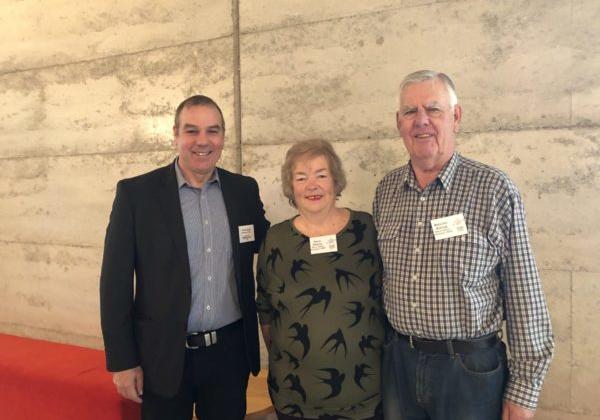 Keith Howe, Rangers Valley with Kerry and Malcolm Bishop, Werai Station
Keith Howe, Rangers Valley with Kerry and Malcolm Bishop, Werai Station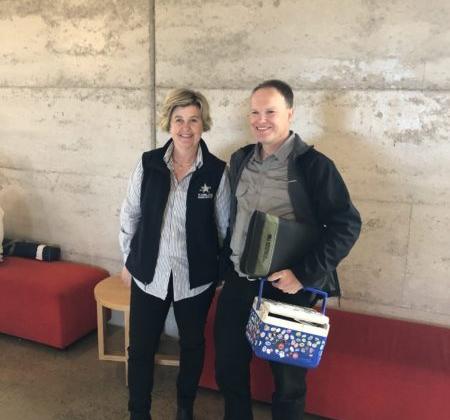 Amanda McFarlane with Dale Gray, Climate Specialst, Agriculture Victoria
Amanda McFarlane with Dale Gray, Climate Specialst, Agriculture Victoria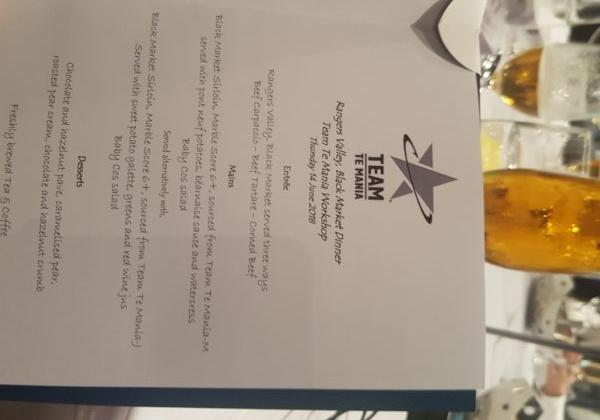 2018 Team Te Mania dinner menu
2018 Team Te Mania dinner menu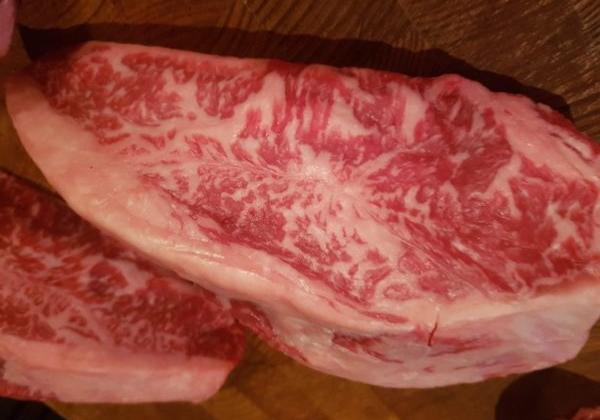 Sire-identified sirloin, marble score 7, produced by Team Te Mania members Richard and Emma McFarlane, Wellington Lodge, Tailem Bend, SA
Sire-identified sirloin, marble score 7, produced by Team Te Mania members Richard and Emma McFarlane, Wellington Lodge, Tailem Bend, SA
